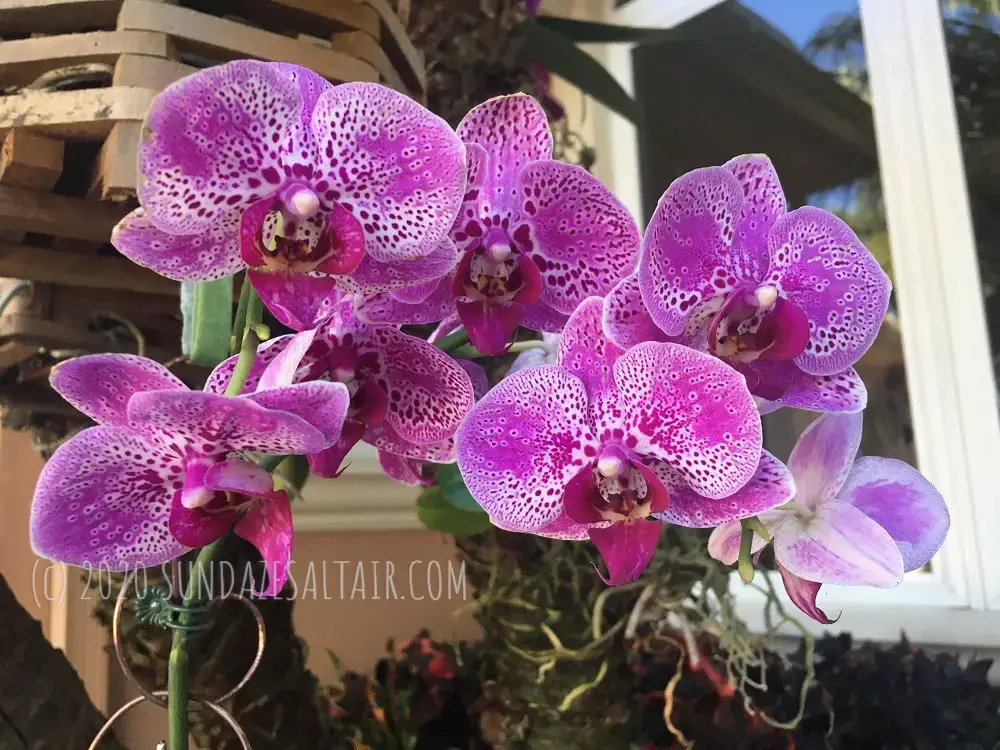Orchids are a very popular flower, and many people grow them in their homes. They are native to tropical climates, so they do not do well in cold weather. If you live in an area with cold winters, you will need to take special care of your orchids to ensure that they survive the winter.
Can orchids be in cold weather? The answer is yes, but they may not bloom as often. Orchids are native to tropical and subtropical regions of the world, so they don’t typically experience freezing temperatures.
However, some species of orchids can tolerate brief periods of cold weather, provided they’re protected from frost. If you live in an area with cold winters, you can still grow orchids outdoors by planting them in a sheltered spot or bringing them indoors when temperatures start to drop.

Credit: www.sundazesaltair.com
What Temperature is Too Cold for Orchids?
Orchids are a tropical plant, so they enjoy warm temperatures. In general, most orchids do best when the temperature is between 70 and 85 degrees Fahrenheit during the day, and 10 to 15 degrees cooler at night. However, there are some orchids that can tolerate colder temperatures – down to 50 degrees Fahrenheit – so it really depends on the type of orchid you have.
When in doubt, err on the side of warmth; if your orchid is looking stressed, it’s probably because it’s too cold.
Can Orchids Be Kept Outside in Winter?
Orchids are a tropical plant, meaning they thrive in warm climates. In winter, temperatures in most of the country dip below what is comfortable for orchids. If you live in a warmer climate, like Florida or California, you can keep your orchid outdoors year-round with no problem.
But if you live anywhere else, it’s best to bring your orchid inside when the temperature starts to drop.
There are a few things to keep in mind if you decide to keep your orchid outdoors during winter. First, make sure the area you place your orchid in gets plenty of sunlight.
Orchids need at least six hours of direct sunlight each day to bloom and stay healthy. Second, be sure to protect your orchid from strong winds. High winds can damage an orchid’s fragile flowers and leaves.
Third, watch the temperature closely. If it starts to dip below 50 degrees Fahrenheit, it’s time to bring your orchid indoors.
With a little care, you can keep your orchid blooming beautifully all winter long – even if that means bringing it inside for part of the season!
Can Orchids Handle 40 Degree Weather?
Orchids are a tropical plant, so they don’t do well in cold weather. They can tolerate some cooler temperatures for short periods of time, but prolonged exposure to temperatures below 40 degrees Fahrenheit can damage or kill them. If you live in an area with colder winters, it’s best to keep your orchids indoors during that time.
There are some varieties of orchids that are more tolerant of cooler temperatures than others, so if you’re interested in growing them outdoors year-round, do your research to find a type that will work in your climate.
How Do You Keep Orchids Alive in the Winter?
Orchids are a beautiful and popular plant to have in the home, but they can be tricky to care for. Many people think that orchids are difficult to keep alive, but with a little know-how, they can be easy to care for. Here are some tips on how to keep your orchid alive and healthy during the winter months.
First, it’s important to know that orchids like cool temperatures. During the winter months, you should keep your orchid in a spot that is between 60-70 degrees Fahrenheit. If your home is too warm, you can put your orchid in the refrigerator for a few hours each day.
Just be sure not to put it in the fridge for more than 12 hours at a time as this can damage the plant.
Another thing to remember is that orchids need bright light but not direct sunlight. During the winter months when there is less sunlight available, you may need to supplement with artificial lighting such as fluorescent bulbs placed about 12 inches from the plant.
Orchids also like high humidity so if your home is particularly dry during the winter months, you may want to invest in a humidifier or mist your plant daily with distilled water. You’ll know your plant needs more humidity if the leaves start to turn brown and crispy looking.
Finally, make sure you’re watering your orchid correctly.
Orchids like evenly moist soil but not soggy soil so water them when the top inch of soil feels dry (but before the leaves start wilting). In general, watering once per week should suffice but be sure to check on your plant regularly as different conditions (such as temperature and humidity) will affect how often it needs watering.
By following these simple tips, you can keep your orchid alive and thriving all year round!
Very Cold Winter Temperatures & Orchid Care
How to Protect Orchids from Cold Weather
Orchids are a beautiful and delicate flower that can add a touch of elegance to any setting. However, they are also quite fragile and need special care to ensure they thrive. One of the biggest threats to orchids is cold weather, which can damage the flowers and even kill the plant.
Here are some tips on how to protect your orchids from the cold:
1. Bring them indoors – If you live in an area that experiences cold weather, it’s important to bring your orchids inside before the temperature drops too low. Place them in a spot that receives indirect sunlight and keep them away from drafts.
2. Create a mini greenhouse – If you can’t bring your orchids indoors, you can create a mini greenhouse for them using a clear plastic container with holes punched in the top for ventilation. Place the container over the plants and secure it with rocks or sandbags so it doesn’t blow away.
3. Water regularly – Orchids need to be watered regularly, even during winter when they are dormant.
Make sure the pot has good drainage so excess water can escape and don’t let the roots sit in water as this can cause rot.
4. Add mulch – A layer of mulch around the base of your orchid will help insulate it against extreme temperatures. Use bark chips, shredded leaves, or straw and apply it around the plant, being careful not to cover up any leaves or stems.
By following these simple tips, you can help ensure your orchids survive even during freezing temperatures!
What Happens If an Orchid Gets Too Cold
If an orchid gets too cold, it can suffer from several problems. The first is that the leaves may turn brown and fall off. This is because the cells in the leaves are damaged by the cold temperatures.
The second problem is that the flowers may drop off prematurely. Finally, the plant may stop growing altogether. If you notice any of these problems, you should move your orchid to a warmer location immediately.
Best Temperature for Orchids in Celsius
Orchids are a beautiful and popular type of flower, but they can be finicky when it comes to temperature. In general, orchids prefer moderate temperatures with some fluctuations throughout the day. They should not be kept in an environment that is too hot or too cold.
Here are some guidelines for the best temperature for orchids in Celsius:
– daytime temperatures should be around 18-24 degrees Celsius
– nighttime temperatures should be 10-15 degrees cooler than during the day
– avoid sudden changes in temperature
– provide some air circulation around your plants
following these guidelines will help your orchids thrive and produce beautiful blooms.
Phalaenopsis Temperature Tolerance
Orchids are some of the most beautiful and popular flowers in the world. They come in a wide variety of colors, shapes, and sizes, and can be found on every continent except Antarctica. Orchids have been cultivated for centuries, and there are now over 25,000 different species.
One of the most popular types of orchid is the Phalaenopsis, also known as the moth orchid. Phalaenopsis are native to tropical regions, and thrive in humid environments with plenty of light. They can be found in a wide range of colors, including white, pink, purple, yellow, and red.
Phalaenopsis are relatively easy to care for at home, making them a great choice for beginners. One important thing to keep in mind when caring for Phalaenopsis is temperature tolerance. These plants like it warm – ideally between 70-85 degrees Fahrenheit during the day and 60-70 degrees Fahrenheit at night.
If your home is too cold or too hot for these temperatures year-round, you may need to provide additional heating or cooling (such as with a grow light or space heater). Providing proper temperature conditions will help your Phalaenopsis flower optimally.
What Temperature is Too Hot for Orchids
Orchids are a delicate flower that can be easily damaged by too much heat. The ideal temperature for orchids is between 68-85 degrees Fahrenheit. Anything above 85 degrees Fahrenheit is considered too hot for orchids and can cause the flowers to wilt and the leaves to scorch.
If you live in an area with high temperatures, it’s important to take measures to protect your orchids from the heat. This can include placing them in a shady spot, using a fan to create a cooling breeze, or misting them with water frequently. By taking these precautions, you can help ensure that your orchids stay healthy and beautiful all summer long.
Do Orchids Like Cold Water
If you love orchids, you might be wondering if they like cold water. The answer is yes and no. Orchids are native to tropical regions and prefer warm temperatures, but they can tolerate brief periods of cold weather.
However, extended exposure to cold temperatures can damage the plant’s roots, leaves, and flowers.
If you live in an area with cool winters, it’s important to protect your orchids from the cold. Bring them indoors or place them in a greenhouse where they will be protected from frost and freezing temperatures.
If you can’t do this, make sure to wrap the plants in burlap or another type of fabric to keep them warm.
In general, it’s best to err on the side of caution when it comes to watering your orchids. Water them only when the soil is dry to avoid root rot.
And when you do water them, use lukewarm water instead of cold water. This will help prevent shock to the plant that can cause damage.
Can Canna Lilies and Orchids Survive in Freezing Weather?
Canna lilies and freezing weather pose a challenge, as they are not naturally suited for extreme cold conditions. While resilient, these plants require protection or removal during frosty periods to prevent damage. In contrast, some orchid species are more adaptable, with certain varieties even tolerating lower temperatures. Proper care, insulation, and frost protection methods can enhance their chances of survival in freezing weather.
Orchid Temperature And Humidity
Orchids are one of the most popular houseplants, and for good reason! They’re beautiful, long-lasting, and relatively easy to care for. However, one of the key things to remember when caring for orchids is that they have specific temperature and humidity requirements that must be met in order for them to thrive.
In general, orchids prefer warm temperatures (between 70-85 degrees Fahrenheit) and high humidity (60-80%). If your home doesn’t naturally meet these conditions, there are a few things you can do to create a more suitable environment for your orchid.
One option is to place your orchid in a bathroom where it will benefit from the steam created by showers.
Another option is to use a humidifier in the room where your orchid is located. You can also create a makeshift “greenhouse” for your Orchid by placing it on top of a tray filled with pebbles and water. The evaporating water will help increase the humidity around your plant.
By providing your Orchid with the proper temperature and humidity, you’ll be well on your way to having a happy and healthy plant that will bloom beautiful flowers year after year!
Conclusion
Orchids are a tropical plant, so they don’t do well in cold weather. The best way to protect your orchid from the cold is to bring it inside when the temperature drops. If you can’t bring it inside, try to cover it with a light blanket or tarp.






